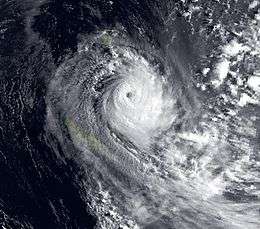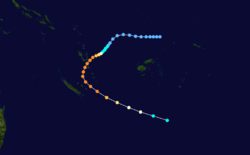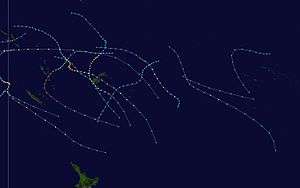Cyclone Prema
Severe Tropical Cyclone Prema was among the worst tropical cyclones to hit Vanuatu since 1987's Cyclone Uma.[1] The twenty-third storm of the season, Prema formed early on 26 March 1993 as a weak tropical depression.[2]
| Category 4 severe tropical cyclone (Aus scale) | |
|---|---|
| Category 4 tropical cyclone (SSHWS) | |
 Satellite image of Cyclone Prema | |
| Formed | 26 March 1993 |
| Dissipated | 6 April 1993 |
| Highest winds | 10-minute sustained: 185 km/h (115 mph) 1-minute sustained: 230 km/h (145 mph) |
| Lowest pressure | 940 hPa (mbar); 27.76 inHg |
| Fatalities | 3 |
| Damage | $5 million (1993 USD) |
| Areas affected | Vanuatu, New Caledonia |
| Part of the 1992–93 South Pacific cyclone season | |
Meteorological history

During 25 March, the Fiji Meteorological Service reported that a tropical depression, had developed within an otherwise inactive monsoon trough, about 200 km (125 mi) to the west of the Fijian dependency of Rotuma.[3][4] During the next day the system initially moved north-westwards, before it turned and moved south-westwards as it organised and developed further.[3]
[5] During that day the depression moved towards the northwest, before it turned and started to move towards the southwest during 26 March as it gradually developed further. During 27 March, both TCWC Nadi and the Joint Typhoon Warning Center reported that the depression had developed into a tropical cyclone with Nadi naming it as Prema.[6]
Preparations and impact
Severe Tropical Cyclone Prema was the first named tropical cyclone to affect Vanuatu after six systems had affected the archipelago during the previous season. Prema affected the island nation between 29 –30 March, where it caused extensive damage parts of Shefa Province, including on Epi, Efate and the Shepherd Islands.
Due to the impact of this system, the name Prema was subsequently retired, by the World Meteorological Organization's RA V Tropical Cyclone Committee.[7]
See also
References
- National Tidal Facility (September 1997). "The South Pacific Sea Level and Climate Change Newsletter". South Pacific Regional Environment Programme. p. 9. Retrieved 13 September 2009.
- Office of the United Nations Resident Coordinator Suva Fiji (March 2002). "Vanuatu — UNITED NATIONS DEVELOPMENT ASSISTANCE FRAMEWORK (2003–2007)". United Nations. Retrieved 13 September 2009.
- Tropical Cyclone Prema, March 24 – April 1, 1993 (Report). Fiji Meteorological Service. 20 May 1996. Archived from the original on 17 April 2013. Retrieved 7 December 2015.
- Darwin Regional Specialised Meteorological Centre (1993). "March 1993" (PDF). Darwin Tropical Diagnostic Statement. Australian Bureau of Meteorology. 12 (3): 2. ISSN 1321-4233. Archived (PDF) from the original on 7 December 2015. Retrieved 7 December 2015.
- National Tidal Facility Australia (2002). "Pacific Country Report Sea Level & Climate: Their Present State Vanuatu" (PDF). Flinders University. p. 15. Retrieved 5 November 2012.
- MetService (22 May 2009). "TCWC Wellington Best Track Data 1967–2006". International Best Track Archive for Climate Stewardship.
- RA V Tropical Cyclone Committee (11 October 2018). Tropical Cyclone Operational Plan for the South-East Indian Ocean and the Southern Pacific Ocean 2018 (PDF) (Report). World Meteorological Organization. pp. I-4–II-9 (9–21). Archived from the original on 12 October 2018. Retrieved 12 October 2018.
External links
- World Meteorological Organization
- Australian Bureau of Meteorology
- Fiji Meteorological Service
- New Zealand MetService
- Joint Typhoon Warning Center
